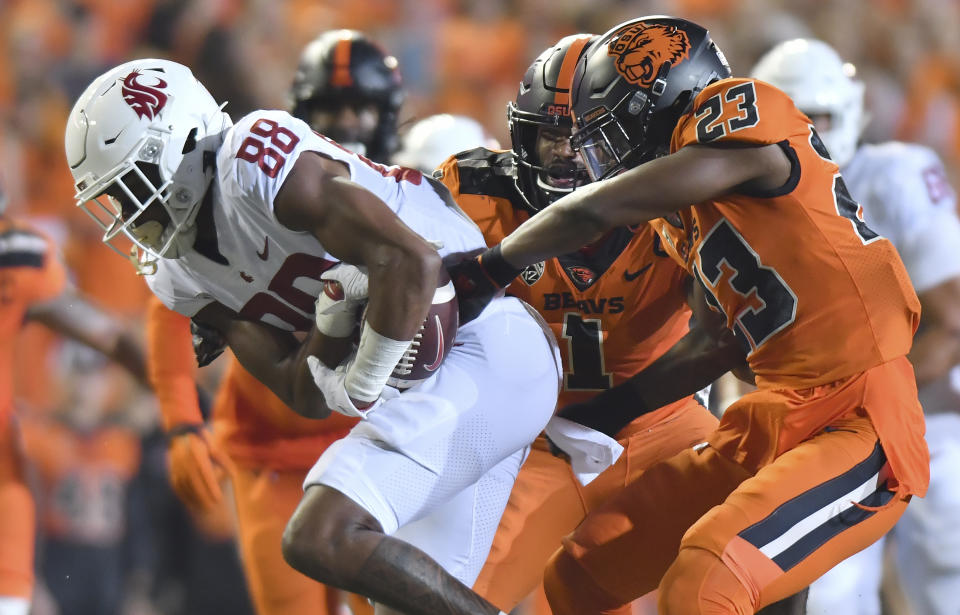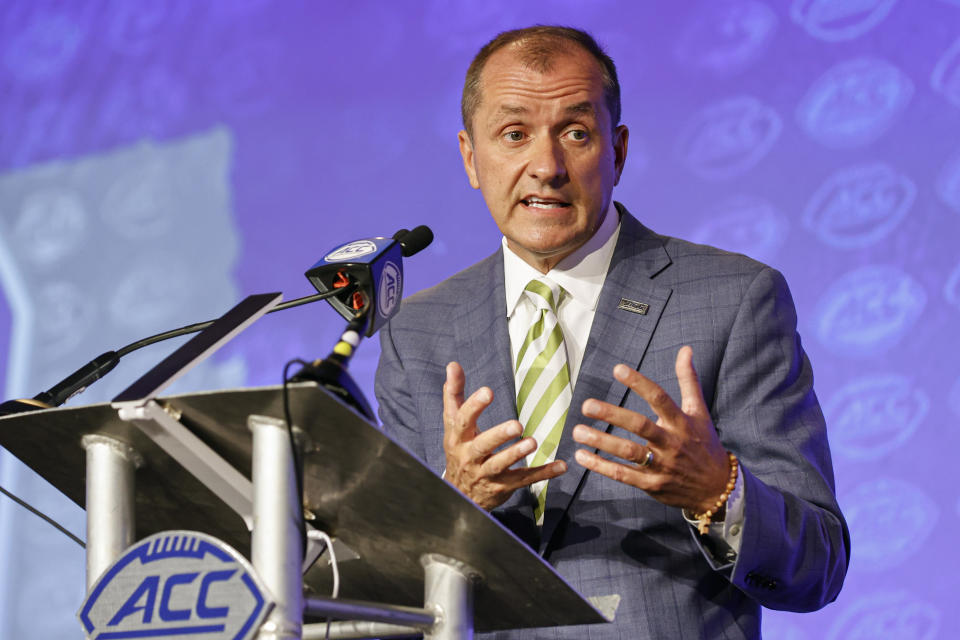Analysis: Conference realignment has mangled the college sports map, but to what benefit?
The Power Five has been whittled down to a Super Four in college sports.
The Pac-12 was the victim, stripped for parts that were redistributed to its competitors for financial gain.
Beyond dollars moving from one bank account to another it’s hard to see the overall benefit, but the most disruptive round of conference realignment at the highest level of college sports appears to be almost over — at least for the near future.
"Are we better or worse? We’ll probably have to have that conversation in five years to see what the second-, third-, fourth-order effects of the decisions that have been made over the last two years,” California athletic director Jim Knowlton said Friday, hours after the Northern California school joined the Atlantic Coast Conference out of pure desperation.
Starting next year, Cal and Bay Area rival Stanford long with SMU, located in Dallas, will compete in an 18-school conference — 17 for football because Notre Dame remains an independent —- that until Friday had no members in states west of the Mississippi.
The ACC now joins the Big Ten, Big 12 and SEC as the super conferences of college sports, all with at least 16 members by August 2024.
The ACC was the last to arrive at the carcass of the Pac-12 after it was plundered by the Big Ten and Big 12 four weeks ago to the day.
“We've gone from regional-based conferences to national, coast-to-coast conferences,” ACC Commissioner Jim Phillips said. “I think that's a lesson for all of us as we all enjoy and love college sports. College sports is going through the next iteration of change and it’s been really drastic. I’m not sure any of us would have predicted this two years ago, but you either get busy or you get left behind.”
This all started in 2021, when it was revealed that Texas and Oklahoma would leave the Big 12 for the Southeastern Conference. That move at least made geographic sense, even if it only served to help the rich get richer and create shockwaves that are still being felt.
The Big Ten countered by going West and adding Southern California and UCLA in the summer of 2022.
The Big 12, weary of being realignment prey, became a predator and targeted the Pac-12 to eliminate a future competition for a shrinking pool of television dollars.
For the ACC, facing internal strife among its membership, expanding its footprint serves to address both short and potential long-term issues.
The ACC needs more money to close a widening gap between the SEC and Big Ten and the rest of the college sports. Expansion helps, though not enough for Florida State to vote for it.
Even with a contract that binds its members together legally though 2036, there has been enough saber-rattling in the ACC — especially by the Seminoles — to make the rest of the conference ponder the possibility of losing members before the deal runs out.
Phillips said he was confident the grant of rights, which could cost hundreds of millions of dollars for an ACC school to break this far out, was strong. But just in case Florida State, Clemson, North Carolina or another member with wandering eyes figures out a way, the ACC will have strength in numbers.
“It’s absolutely good financially for us, but it also provides some stability,” Phillips said.
Phillips has seen the results of inaction in the current climate of college sports.
Back when the Big 12 was teetering, the Pac-12 had the opportunity to strike a final blow, but couldn't get its members to understand that Power Five conferences are not partners but competitors. Instead, the Pac-12 formed what turned out to be a meaningless alliance with the ACC and Big Ten.
Now there are just two Pac-12 schools remaining, Oregon State and Washington State, and they are facing the grim financial ramifications of Power Five consolidation.
“We need to we need to absolutely face the reality that the revenues that we will be receiving will be less," Oregon State athletic director Scott Barnes said.
There is a possibility the Pac-12 brand survives. Oregon State and Washington State now control the conference's assets, which includes tens of millions of dollars the conference earned from its recent performances in the NCAA men's basketball tournament.
Instead of joining the Mountain West, the most logical geographic fit, some type of merger could be in order. There could even be one last burst of realignment as the most successful and prosperous schools still left out consider a best-of-the-rest league.
Realignment is also trickling down to the College Football Playoff, which expands from four to 12 teams next year.
Ironically, when CFP leaders agreed to ensure six conference champions a spot in the bigger field — an announcement that came on the Friday of Labor Day weekend last year — there was talk about how the new format could quell conference realignment.
Instead, the very same conference commissioners who have mangled the college sports map with realignment, will now have the opportunity to consolidate more of the power and money to an even small number of conferences.
The pursuit of billions of dollars driven by the desire of television networks to broadcast college football games has led to awkward partnerships and decisions that appear to have little regard for tradition, fans, the athletes who compete and long-term consequences.
“We’re at another point of inflection of historical change, a very interesting one,” Cal Chancellor Carol Christ said. "We have to answer the question probably in five years are we better or worse?”
___
Follow Ralph D. Russo at https://twitter.com/ralphDrussoAP and listen at http://www.appodcasts.com
___
AP college football: https://apnews.com/hub/college-football and https://apnews.com/hub/ap-top-25-college-football-poll






